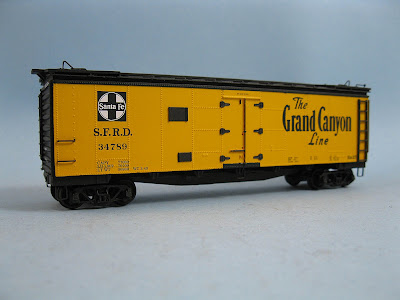While this blog isn't very active, Harlem Station is still going strong behind the scenes. The layout itself is now in storage waiting to be housed in a new hobby room I'm planning to build in my basement. Also, I've have continued acquiring rolling stock over the year to build up the fleet. It is my hope the layout will find its new home by Christmas Holidays if everything goes according to my plan... and we know life never follow plans!
Parameters
Trying to
fit an island layout into a new room isn’t an easy task. No wonder this kind of
design has lost favor of most modellers over the years. They quickly eat up
space when you take into account decent aisles where an around the wall design
would be much more compact. But reality is reality and Harlem Station is indeed
an island design in real life. It couldn’t have been done otherwise.
Knowing
that, I’ve started to look at my options and to better grasp the reality of the
project, it was wise to set a few parameters that can’t be fiddled with. From
the start, I decided to have aisles that would be about 42 inches wide. I know it
is quite generous, but I’ve always felt the standard practice of 30” was a
minimum rather than a recommendation. Operation is one thing, another is having
enough space to work or build the layout… and to have enough space to
contemplate our work. I see no point giving our best on a layout only to
display it poorly.
Once I had to
determine the layout and aisles footprint, I was ready to design the room. I
know for sure I want an entire wall dedicated to my workbench, including a
spray booth and a computer. I have an old desk about 60” long by 30” wide that
serves me well for this purpose, so let’s consider we need a good 30” wide area
for these things and add some more inches for the chair. Shelving and storage
will be provided and several power outlets are required. Since the basement
walls are stone masonry and can’t be hidden with new finishes, this modelling
station should be located on a new interior wall to make my life easier with
electrical wiring.
Another key
aspect is the future Temiscouata Railway layout I’m planning to build in the
future. This layout requires about 17 feet long to accurately replicate
Connors, NB without any compression. This is a condition I’m not eager to
sacrifice since I know longer believe compressing railway scenes when not
required.
I have also
some diomara ideas, but theses won’t require a lot of space and could be hanged
on brackets over Temiscouata layout staging area.
A final key
design element is that I have accumulated an extensive collection of rolling
stock over the years and it is getting harder and harder to find a particular
item among 300 or 400 boxes. If possible, I’d like to use the space under the
Temiscouata layout as a storage area. It could be made of cupboard or shelving
units where cars could be picked up easily. For Harlem Station, I’m thinking
about using a small service table on caster to stage cars and store them under
the layout.
Putting Things
Together
 |
| Proposed hobby room layout |
Architectural
design, like any other design process, required a balance between technical
requirements and aesthetics. Too often, we take a room and put a layout into
it, not thinking how it will look. If Hedley Junction taught us a lesson, it’s
that large aisle can truly make a layout stand out and that locating a nice
scene on the peninsula, which grabs visitor’s attention when they cross the door
step, is a mission statement in itself.
For my
hobby room, I want the same thing. The layouts should command the area and be
the main focal points. Modelling is an art and should be displayed as such. I
particularly like the idea of Harlem Station standing in the middle of the
room, basking in light and set up on a well-crafted support. Imagine a billiard
table and you’ve got a got idea of what I have in mind. Some cozy, that focus
your attention on the layout as if it was a game and where it is enjoyable to
spend some quality time operating with friends.
As a
backdrop to this, Temiscouata Railway can be seen on the exterior walls,
creating a backdrop that wraps around Harlem Station. It would also be
carefully lighted and supported by nicely finished storage units.
Now, think
about the lighting. Depending on which task you are performing, you can turn on
Harlem Station independently from Temiscouata, helping you to focus on what
matters.
As a final
touch, instead of creating a bland room, large windows will be installed in the
new wall so the layout room isn’t simply a box, but rather an environment
basking in light and that can breathe. Finishes will probably be painted wainscoting
with trims and old colors similar to what was common in railway architecture.
Not too fancy, just some character to give personality and warmth to room.
In my
modelling life, I’ve seen many modellers that can be considered the best of their
trade. Their work is exceptional and breath-taking, however, how many times
were I completely flabbergasted to see my favorite work to be literally buried
in the most unimaginable mess ever. On the other end of the spectrum, you’ll
also find great layouts but display in an aseptic environment basked in monotone
fluorescent lighting. A part of a layout success as a lot to do with how we
display it, be it in terms of enjoyment, operation and construction.



















